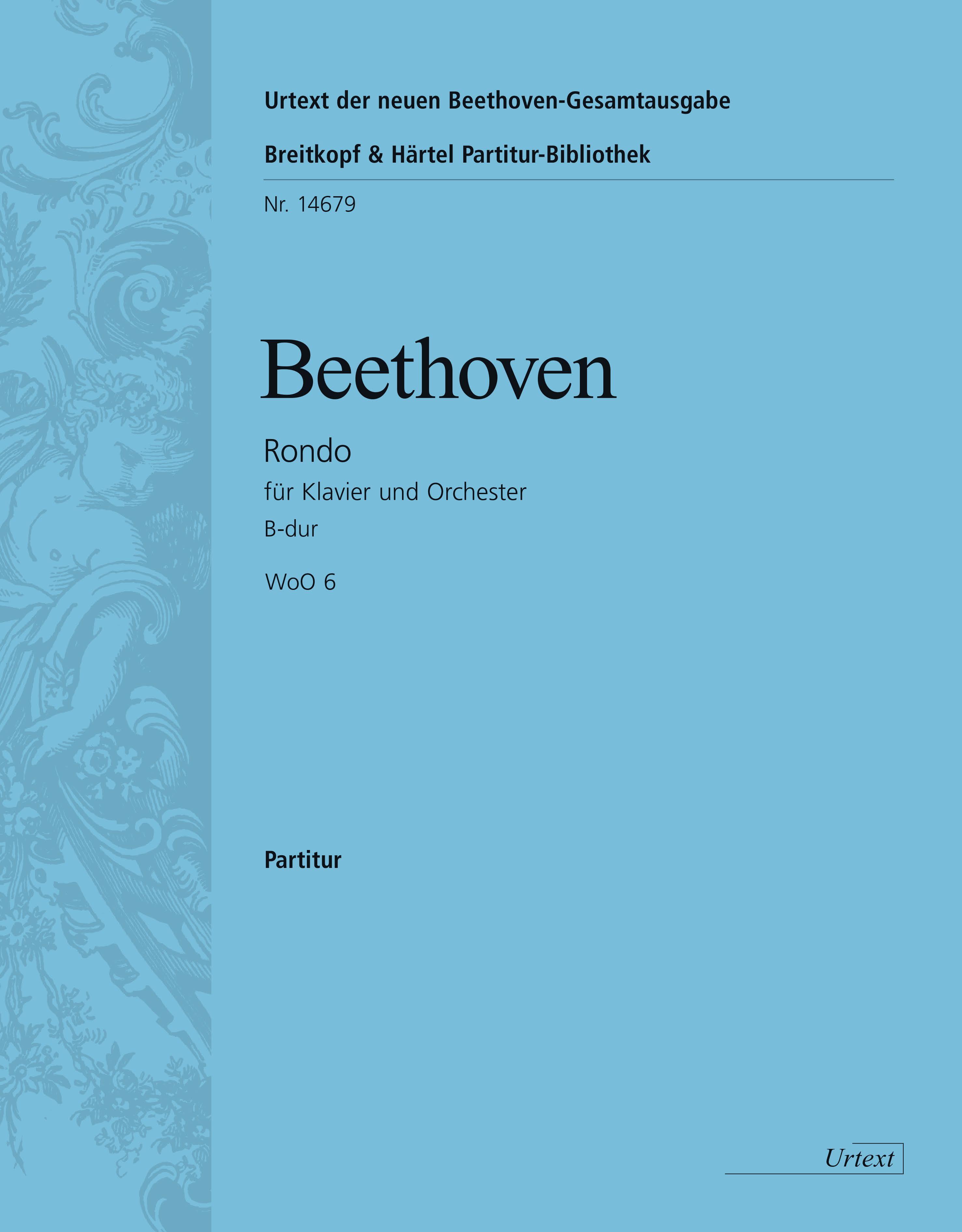




(1770–1827)
für Klavier und Orchester
B-dur
Ursprüngliches Finale des Klavierkonzerts Nr.2
Rondo for Piano and Orchestra in B flat major Original Finale of the Piano Concerto No.2
WoO 6
herausgegeben von/edited by Hans-Werner Küthen
Urtext der neuen Beethoven-Gesamtausgabe
Urtext from the new Beethoven Complete Edition
WIESBADEN · LEIPZIG · PARIS
Partitur-Bibliothek 14679
Printed in Germany
FlöteFlute
2 Oboen2 Oboes
2 Fagotte2 Bassoons
2 Hörner2 Horns
StreicherStrings
AufführungsdauerPerforming Time
etwa 10 Minutenapprox. 10 minutes
Dazu käuflich lieferbar:Available for sale: OrchesterstimmenOB 14679Orchestral partsOB 14679
Ausgabe für zwei KlaviereEdition for two Pianos (H.-W. Küthen/J.Umbreit/A.Groethuysen)(H.-W. Küthen/J.Umbreit/A.Groethuysen)
G. Henle VerlagHN 1149G. Henle VerlagHN 1149 Studien-EditionStudy edition
G. Henle VerlagHN 9807G. Henle VerlagHN 9807
Urtextausgabe der im G. Henle Verlag, München, erschienenen Gesamtausgabe Beethoven Werke, herausgegeben vom Beethoven-Archiv, Bonn, Abteilung III, Band 5, herausgegeben von Hans-Werner Küthen.
Urtext edition from the complete edition Beethoven Werke, section III, volume 5, edited by Hans-Werner Küthen, issued by the Beethoven-Archiv, Bonn, and published by G. Henle Verlag, Munich.
Das Rondo B-dur WoO 6 von Ludwig van Beethoven (1770–1827) bildete ursprünglich den Schlusssatz des 2. Klavierkonzerts op. 19. Seine kompositorische Anlage weist, vor allem durch den ungewöhnlichenEinschub eines Andante, einen deutlichen Bezug zu Mozart auf. Dieser Bezug dürfte sehr wahrscheinlich die Ursache für die Eliminierung als Schlusssatz seit der dritten Version des Konzerts aus den Jahren 1794/95 gewesen sein. In den 1780er Jahren war die GattungKlavierkonzert nach Mozarts neuen Maßstäben auf dem Kontinent etabliert und zu solcher Blüte gebracht worden, dass auch Beethoven sich umorientieren musste, wie die insgesamt vier Versionen seines B-dur-Konzerts lebhaft genug vor Augen führen.1
Das Rondo WoO 6 ist wahrscheinlich eine Zweitfassung von 1793 und wurde in Wien aus einer Bonner Frühfassung überarbeitet. Es kann inzwischen als sicher angesehen werden, dass Beethoven WoO 6 als ursprünglichen Schlusssatz der beiden Erstversionen des B-dur-Klavierkonzerts verwendet hatte. Nicht nur dieselbe Besetzung, vielmehr die fast wörtliche Übernahme einer hinreichend charakteristischen Motivgruppe aus WoO 6 (T. 346–348 und 353–355) an proportional vergleichbarer Stelle im endgültigen Rondo von Opus 19 (T. 283–285 und 291–293), die beide mit ihrer jeweiligen Wiederholung kongruent angelegt sind, schließen Zufälligkeiten aus. Der kompositorische Rückgriff auf sein früheres Rondo zeigt sich konkret in dessen Quelle2 an denselben oben genannten Stellen, die in das endgültige Finale des Opus 19 übernommen wurden. In diesen Takten des Wiener Autographs begegnet die einzige Artikulationsnotierung im ganzen Solopart; es ist anzunehmen, dass sie anlässlich der fast wörtlichen Übernahme mit der Niederschrift im endgültigen Finale rückwärtsgerichtet ergänzt wurde. Überdies geht die Idee eines Andante-Einschubs auf eine frühere Notierung im „Kafka“-Skizzenkonvolut zurück3 und weist mit einer thematischen Übernahme dieses Wiener Autograph von WoO 6 als eine oben bereits apostrophierte Zweitfassung aus.
Dass Beethoven sich nicht entschließen konnte, das Autograph dieses Finalsatzes entweder zu vernichten oder zu veröffentlichen, sondern es bis zu seinem Tod unter seinen Musikalien mitführte, bestätigt neben einem sozusagen historischen Sinn für die eigene schöpferische Entwicklung auch seine persönliche Wertschätzung eines Stückes, das kaum mehr als Alternative, wohl aber als Erinnerung an seine Auseinandersetzung mit einem Modell Mozarts aufbewahrt zu werden verdiente. Es bleibt somit das frühesterhaltene
Autograph einer vollständigen Partitur Beethovens. Sein originaler Text wurde in der neuen Beethoven-Gesamtausgabe zum ersten Mal vorgelegt.4 Und es gibt darin eine bemerkenswerte Gemeinsamkeit mit Mozart: Beinahe an derselben Stelle der Rückführung eines langsamen 62-taktigen Andante-Intermezzos ins Rondo-Allegro begegnen gewisse Schwierigkeiten, die schon Mozart beim Tempo IÜbergang angetroffen hatte. Wenn dieser in seinem Es-dur-Klavierkonzert KV 482 im Finale einen Andantino cantabile-Einschub mitten in ein Rondo komponierte, mochte das für Beethoven eine irisierende Ausnahme darstellen, die es nachzuahmen, womöglich zu übertreffen galt. Der unbewältigte Versuch ist in Beethovens Autograph deutlich sichtbar und war wohl Grund genug, dieses Finale gegen einen konventionelleren Schlusssatz ohne langsamen Tempoeinschub zu ersetzen.
WoO 6 wurde 1829 postum bei Anton Diabelli & Comp. in Wien veröffentlicht. Carl Czerny hatte den Text nach dem Autograph modernisiert und im Diskant bis zum f 4 erweitert. Seine Bearbeitung kann nicht als autorisiert gelten; gleichwohl wurde der von ihm analog zu den Orchesterinstrumenten im Klavierpart ergänzten Artikulation gefolgt. Hauptquelle der vorliegenden Ausgabe ist das Partiturautograph Beethovens. Ergänzungen des Herausgebers stehen in runden Klammern. Für eine ausführliche Darstellung der Quellen und Lesarten sei auf den Kritischen Bericht des oben erwähnten Gesamtausgaben-Bandes verwiesen.5 Herausgeber und Verlag danken allen Bibliotheken und Institutionen, die Quellen bereitgestellt haben.
Bonn, Frühjahr 2012Hans-Werner Küthen
1Vgl. Näheres im Vorwort zu Opus 19 in: Beethoven Werke. Gesamtausgabe, Abteilung III, Bd. 2, Klavierkonzerte I, hrsg. von Hans-Werner Küthen, München 1984, sowie im entsprechenden Klavierauszug des G. Henle Verlags, München 1991, HN 434.
2Autographe Partitur, Wien, Archiv der Gesellschaft der Musikfreunde, Signatur A3
3London, British Library, Signatur Add. Ms. 29 801, fol. 75v.
4 Beethoven Werke. Gesamtausgabe, Abteilung III, Bd. 5, Klavierkonzerte III, hrsg. von Hans-Werner Küthen, München 2004 [= BGA III/5].
5BGA III/5, S. 162.
The Rondo in B flat major WoO 6 by Ludwig van Beethoven (1770–1827) originally constituted the closing movement of his Piano Concerto no. 2 op. 19. Its compositional structure shares a distinct kinship with Mozart, in particular through the unusual insertion of an Andante. This reference is most likely the reason why the piece was rejected as the closing movement by the time that the Concerto had reached its third version (1794–95). In the 1780s, the genre of the piano concerto had established itself on the Continent within the new parameters set by Mozart and had blossomed so richly that Beethoven also had to re-orient himself – a situation made vividly clear by the altogether four versions of the B-flat major Concerto.1
The Rondo WoO 6 is probably a second version written in 1793, constituting an early Bonn version that was revised in Vienna. It is today considered as certain that Beethoven had originally planned WoO 6 to be the closing movement of the first two versions of his B-flat majorConcerto. Not only the identical scoring precludes coincidences, but also – a weightier reason yet – the almost note-fornote borrowing of a sufficiently distinctive motivic group from WoO6 (mm. 346–348 and 353–355) in comparable passages at a similar stage of the final Rondo of op.19 (mm. 283–285 and 291–293), both of which instances are congruent with their respective repetition. The fact that Beethoven draws on his earlier Rondo is clearly evident in its source2 at the same above-mentioned passages, which were included in the definitive finale of op. 19. The sole articulation in the entire solo part is found in these measures of the Vienna autograph; it can be assumed that it was supplemented post factum during the almost literal borrowing of these measures in the definitive finale. Moreover, the idea of an Andante insert goes back to an earlier notation to be found in the “Kafka” sketch miscellany,3 and its thematic borrowing proves the Vienna autograph of WoO 6 to be a second version, as mentioned above. Beethoven could not decide whether to destroy or to publish the autograph of this final movement, but kept it among his musical manuscripts until his death. Besides confirming what one might call a historical sense of the composer’s own creative development, it proves his personal esteem for a piece that deserved to be preserved not as an alternative but rather as a remembrance of his creative treatment of a model by Mozart. It thus remains the earliest surviv-
ing autograph of a complete score by Beethoven. Its original musical text was first published in the new Beethoven Complete Edition.4 And it shares a remarkable feature with Mozart: at almost the same point in the transition from the slow, 62-measure-long AndanteIntermezzo back to the Rondo-Allegro, it is impossible not to sense the same difficulties that Mozart had also encountered at his “Tempo I” transition. If, in the finale of his E-flat major Piano Concerto K. 482, Mozart inserted an “Andantino cantabile” section in the middle of a Rondo movement, then Beethoven might have seen this as an iridescent exception that was worthy of being emulated or, perhaps, even surpassed. Beethoven’s attempt to tackle this challenge is clearly visible in his autograph and was probably reason enough for him to replace this finale with a more conventional closing movement without a slow insert.
WoO 6 was published posthumously in 1829 by Anton Diabelli et Comp. in Vienna. Carl Czerny modernised the text after the autograph and expanded the treble range up to f 4. Although his arrangement cannot be considered as authorised by the composer, we have nevertheless followed the articulation which he added in the piano part, in line with that of the orchestral instruments. The primary source for the present edition is Beethoven’s autograph score. For a more detailed description of the sources and readings, please consult the Critical Report of the above-mentioned Complete Edition.5 The editor and publisher are grateful to all the libraries and institutions that have supplied source material.
Bonn, Spring 2012Hans-Werner Küthen
1Cf. further details in the Preface to op. 19 in: Beethoven Werke Gesamtausgabe, section III, vol. 2, Klavierkonzerte I, ed. by Hans-Werner Küthen, Munich, 1984, as well as in the corresponding piano reduction of G.Henle Publishers, Munich, 1991, HN 434.
2Autograph score, Vienna, Archiv der Gesellschaft der Musikfreunde, shelfmark A3
3London, British Library, shelfmark Add. Ms. 29 801, fol. 75v.
4 Beethoven Werke Gesamtausgabe, section III, vol. 5, Klavierkonzerte III, ed. by Hans-Werner Küthen, Munich, 2004 [= BGA III/5].
5BGA III/5, p. 162.
Pianoforte
Ludwig van Beethoven WoO 6 herausgegeben von Hans-Werner Küthen
Violoncello
Contrabbasso
This is an excerpt. Not all pages are displayed. Have we sparked your interest? We gladly accept orders via music and book stores or through our webshop at www.breitkopf.com. Dies ist eine Leseprobe.
Nicht alle Seiten werden angezeigt. Haben wir Ihr Interesse geweckt?
Bestellungen nehmen wir gern über den Musikalien- und Buchhandel oder unseren Webshop unter www.breitkopf.com entgegen.
